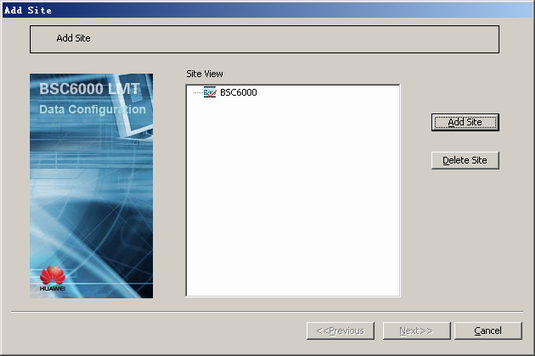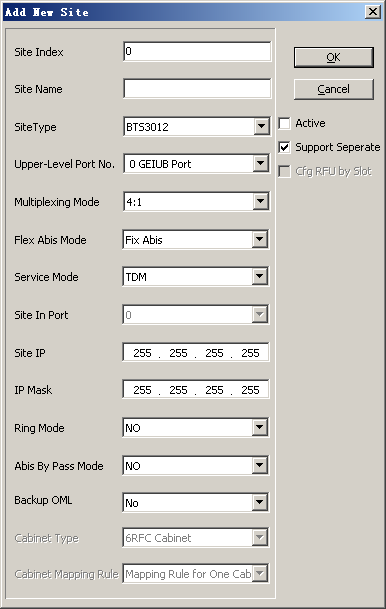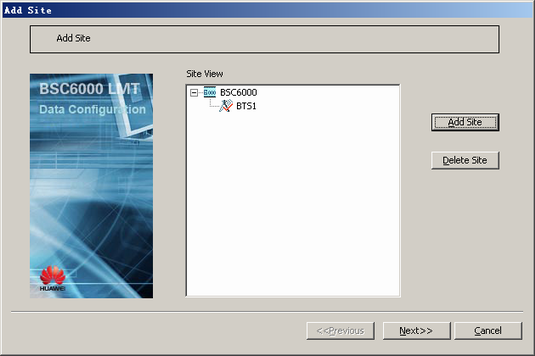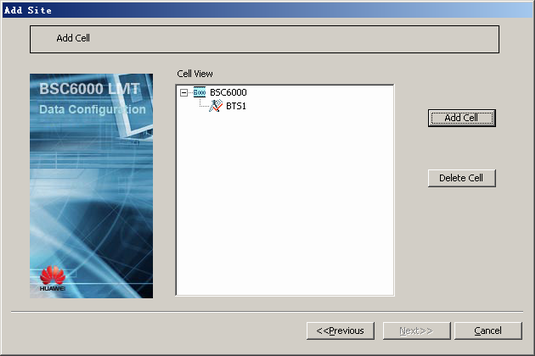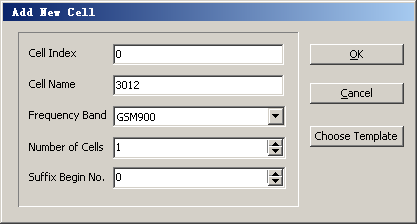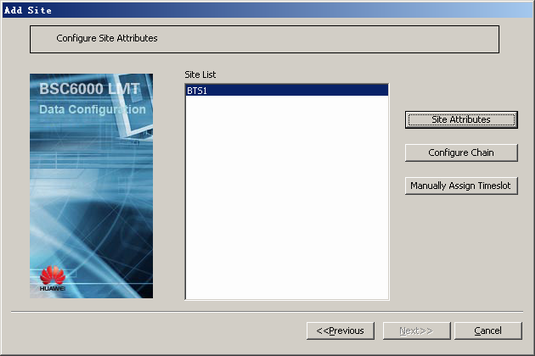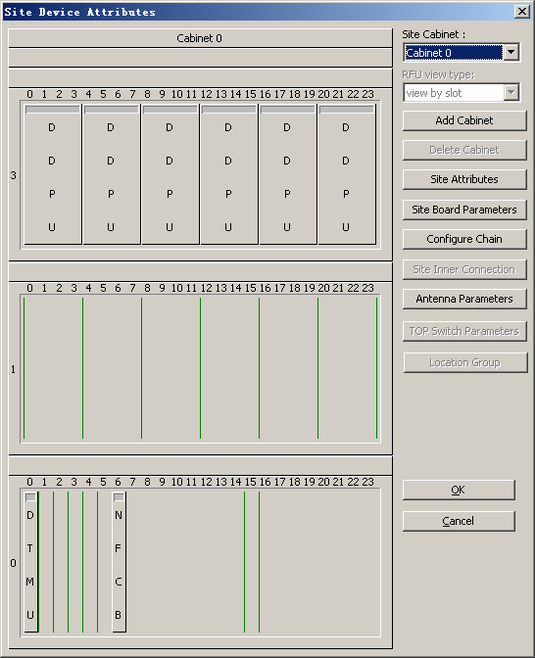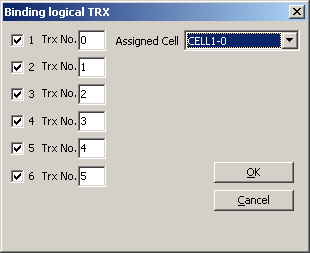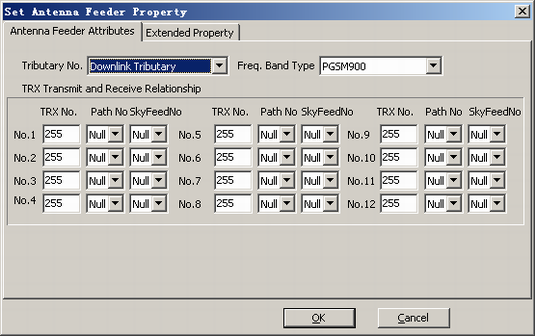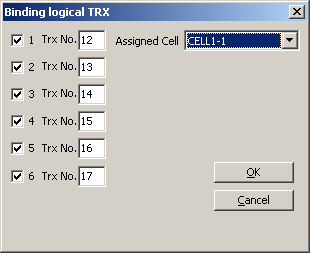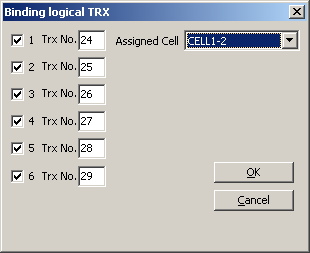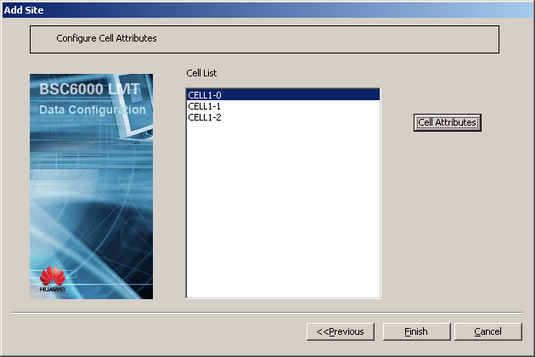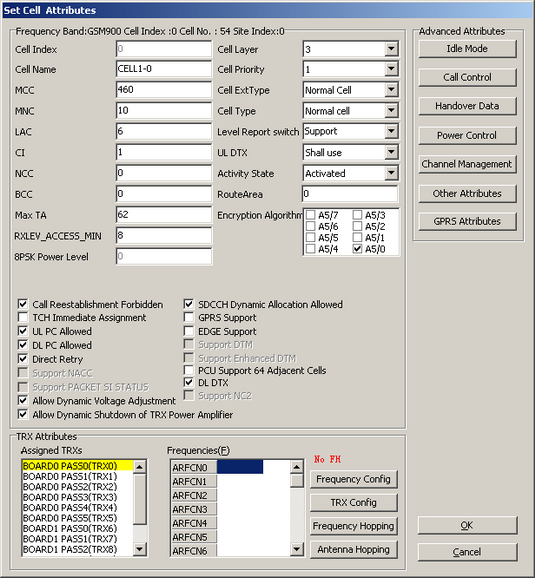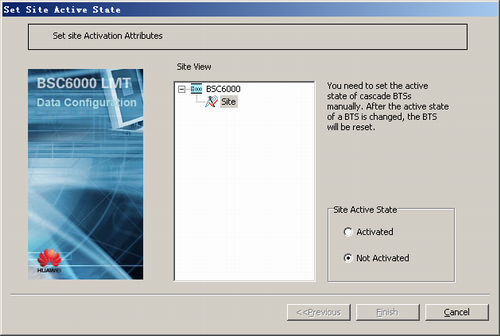This describes how to configure the S12/12/12 for the BTS3012 by using the QTRU.
| Scenario | BSC initial configuration and BSC capacity expansion |
| Mandatory/Optional | Optional. The BTS3012 S12/12/12 is configured when necessary. |
The procedure for configuring the S12/12/12 for the BTS in TDM transmission mode is the same as that for configuring the S12/12/12 for the BTS in HDLC/HUB transmission mode.
On one QTRU, one physical TRX is bounded with six logical TRXs. To ensure bandwidth, you are advised to add site chains.
Prerequisites
- The GEIUB/GOIUB is configured. For details, see Configuring the GEIUB/GOIUB.
- There are idle ports on the GEIUB/GOIUB in the GMPS or GEPS.
- The GXPUM is configured for the GMPS/GEPS where the GEIUB/GOIUB is located. For details, see Configuring the GXPUM.
Preparation
Parameter |
Example |
Source |
|
|---|---|---|---|
Site Attributes dialog box |
Site Name |
BTS 1 |
Network planning |
SiteType |
BTS3012 |
Network planning |
|
Upper-Level Port No. |
GEIUB Port 0 |
Network planning |
|
Multiplexing Mode |
4:1 |
Network planning |
|
FlexAbis Mode |
Fix |
Network planning |
|
Service Mode |
TDM/HDLC/HUB BTS |
Network planning |
|
Support Separate |
Selected |
Network planning |
|
Active |
Deselected |
Network planning |
|
Config Ring |
No |
Network planning |
|
Config AbisByPass |
No |
Network planning |
|
Cell attributes |
Number of Cells |
3 |
Network planning |
Cell Name |
Cell 1-0, cell 1-1, cell 1-2 |
Network planning |
|
Frequency Band |
GSM900 |
Network planning |
|
MCC |
460 |
Network planning |
|
MNC |
01 |
Network planning |
|
LAC |
8240 |
Network planning |
|
CI |
1, 2, 3 |
Network planning |
|
BCC |
1 |
Network planning |
|
NCC |
1 |
Network planning |
|
Cell Extension Type |
Common cell |
Network planning |
|
Cell Type |
Common cell |
Network planning |
|
TRX Attributes |
Assigned Cell |
Cell 1-0, cell 1-1, and cell 1-2 |
Network planning |
Frequency configuration |
36 (main BCCH frequency), 40, 48, 52, 56, 60, 64,, 68, 72, 76, 80, and 84; 37 (main BCCH frequency), 41, 49, 53, 57, 60, 65,, 69, 73, 77, 81, and 85; 38 (main BCCH frequency), 42, 50, 54, 58, 61, 66,, 70, 74, 78, 82, and 86 |
Network planning |
|
TRX configuration |
TRX0, TRX1, TRX2, TRX3, TRX4, TRX5, TRX6, TRX7, TRX8, TRX9, TRX10, and TRX11; TRX12, TRX13, TRX14, TRX15, TRX16, TRX17, TRX18, TRX19, TRX20, TRX21, TRX22, and TRX23; TRX24, TRX25, TRX26, TRX27, TRX28, TRX29, TRX30, TRX31, TRX32, TRX33, TRX34, and TRX35 |
Network planning |
|
FH Mode |
None |
Network planning |
|
Antenna feeder attributes |
Tributary No. |
Downlink Tributary |
Network planning |
Frequency Band |
PGSM900 |
Network planning |
|
TRX Transmit and Receive Relationship |
TRX No.1: 0, Null, A; TRX No.1: 1, Null, and B TRX No.1: 2, Null, A; TRX No.1: 3, Null, and B TRX No.1: 4, Null, A; TRX No.1: 5, Null, and B |
Network planning |
|
Site Chain |
Port No. |
GEIUB Port 1 |
Network planning |
Site Port No. |
Site Port 1 |
Network planning |
|
Procedure
- Start the wizard for adding a BTS.
- When adding a BTS for the first time, you can start the wizard for adding a BTS only on the GEIUB/GOIUB in the GMPS or GEPS. On the BSC6000 Local Maintenance Terminal, right-click a GEIUB in the GMPS.
- If a BTS already exists, you can add a cascaded BTS under this BTS. On the Management Tree tab page, right-click a BTS.
- Choose . A dialog box is displayed, as shown in Figure 1.
- Click Add Site. A dialog box is displayed, as shown in Figure 2.
- Set the parameters by referring to Table 1.
- Click OK. A dialog box is displayed, as shown in Figure 3.
- Click Next. A dialog box is displayed, as shown in Figure 4.
- Select a BTS, and then click Add Cell. A dialog box is displayed, as shown in Figure 5.
- Set the parameters by referring to Table 1.
 NOTE:
NOTE: To add multiple cells at a time, set Number of Cells. The added cells are named in the format of current Cell Name + sequence number.
- Click OK. A dialog box is displayed, as shown in Figure 6.
- Click Next. A dialog box is displayed, as shown in Figure 7.
- Click Site Attributes. A dialog box is displayed, as shown in Figure 8.
- Configure S6 for cell 1-0.
- Configure S12 for cell 1-1.
- Configure S12 for cell 1-2.
- Delete redundant DDPUs and click OK to return to the dialog box, as shown in Figure 7.
- Click Add Chain. A dialog box is displayed, as shown in Figure 15.
- Click Add Chain. A dialog box is displayed, as shown in Figure 16.
- Set the parameters by referring to Table 1.
- Click OK to return to the dialog box, as shown in Figure 15.
- Click OK to return to the dialog box, as shown in Figure 7.
- Click Next. A dialog box is displayed, as shown in Figure 17.
- Select the added cell, and then click Cell Attributes. A dialog box is displayed, as shown in Figure 18.
- Set the basic attributes of cell 1-0, cell 1-1, and cell 1-2 in sequence by referring to Table 1.
 NOTE:
NOTE: - For two cells, the values of at least one of the following parameters should be different: MCC, MNC, LAC, and CI.
- If you select GPRS Support, the BSC must be configured with the PCU. If the BTS does not support the GPRS function or the GPRS services are unavailable in the cell, do not select GPRS Support.
- When you select EDGE Support, GPRS Support is selected automatically if the GPRS function is not enabled. You also need to select a PCU from the PCU drop-down list.
- For frequencies on the same QTRU, the absolute value of the difference between the minimum frequency and the maximum frequency cannot exceed 61.
- Click OK to return to the dialog box, as shown in Figure 17.
- Click Finish. The configuration of the BTS3012 S12/12/12 is complete.
- Activating a BTS.
